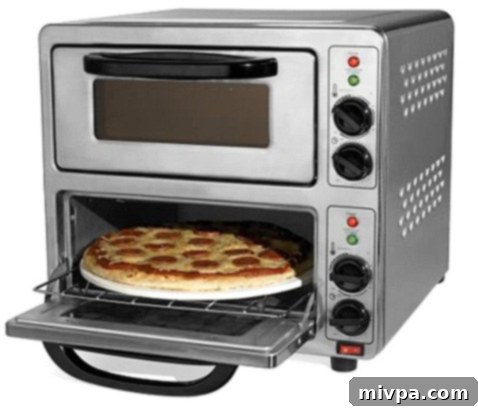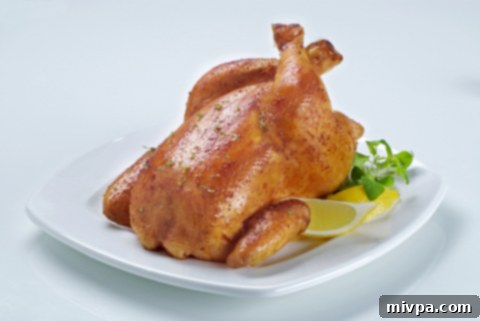Bake It, Don’t Fry It: The Ultimate Guide to Healthy Oven Cooking Over Deep Frying
Welcome to a healthier you! In our ongoing journey to embrace more nutritious eating habits, this week we’re diving deep into a fundamental choice in the kitchen: baking versus deep-frying. While the crispy, golden allure of deep-fried foods is undeniably tempting, understanding the profound health implications of this cooking method compared to its oven-baked counterpart is crucial for long-term well-being. This article will thoroughly explore why making the switch to baking is not just a culinary preference but a significant step towards better health, and perhaps most practically, provide you with the insights needed to convert your favorite deep-fried recipes into healthier, oven-baked delights.

Our discussion draws upon insightful research and practical advice, particularly from reliable sources like www.livestrong.com, which has extensively covered the subject of healthy food preparation. This comprehensive guide aims to consolidate that wisdom, making it accessible and actionable for every home cook looking to improve their dietary habits and overall health.

Understanding the Superiority of Baking for Your Health
Adopting a healthier lifestyle often involves a series of conscious and deliberate choices. Beyond physical activity, stress management, and avoiding harmful habits like smoking, making informed dietary decisions is paramount. A truly healthy diet emphasizes abundant fruits and vegetables, prioritizes nutrient-dense whole grains over refined carbohydrates, moderates sodium intake, limits alcohol consumption, and critically, significantly reduces the intake of unhealthy fats. Among the most impactful changes you can implement to dramatically lower your dietary fat intake is the transition from preparing foods by deep-frying to oven baking. This simple swap can unlock a cascade of health benefits that resonate throughout your body.
The Hidden Dangers Lurking in Deep-Fried Foods
Advanced Glycation End Products (AGEs): A Silent Threat
When foods, especially those rich in starches or coated in starchy breadings, are exposed to the extremely high temperatures characteristic of deep-frying, a detrimental chemical reaction occurs. This process leads to the formation of Advanced Glycation End Products, or AGEs. Consider everyday examples like french fries, where the potato itself is starchy, often further coated in more starch, and then plunged into scalding hot oil. The intense combination of starches and high heat creates these harmful compounds, which have been identified as potential carcinogens. Research, such as that published in “Molecular Nutrition and Food Research,” has compellingly linked elevated levels of AGEs to a spectrum of chronic diseases, including but not limited to type 2 diabetes. While ongoing scientific inquiry continues to fully uncover the extent of their harm, the accumulating evidence strongly suggests that minimizing AGEs in our diet is a prudent and proactive health strategy.
Beyond the immediate health concerns, AGEs are also intimately implicated in the physiological aging process and the development of numerous age-related diseases. They can accumulate in various tissues and organs, contributing to cellular damage, oxidative stress, and systemic inflammation throughout the body. Conditions like atherosclerosis, kidney disease, Alzheimer’s, and even certain types of cancer have been associated with high AGEs intake. Reducing your consumption of deep-fried and heavily processed foods is a key, foundational step in mitigating your exposure to AGEs, thereby making baking a far safer and more beneficial alternative for long-term health.
The Peril of Partially Hydrogenated Oil: Understanding Trans Fats
A significant portion of deep-fried items, particularly those ubiquitous in restaurants and fast-food establishments, are cooked using partially hydrogenated oils. These oils are favored by the food industry for several reasons: their lower production cost, extended shelf life without spoilage, and remarkable stability at the high cooking temperatures required for deep-frying. Essentially, they represent an economically attractive and practical staple for high-volume cooking operations. However, the health costs associated with these oils, commonly known as trans fats, are alarmingly high and well-documented. According to the Harvard School of Public Health, trans fats are estimated to be responsible for a staggering one in five heart attacks in the United States alone. Their detrimental effects extend far beyond the heart, promoting systemic inflammation, diminishing the efficacy of the immune system, significantly contributing to obesity, and increasing the risk of numerous chronic illnesses, including stroke and diabetes. Consciously avoiding foods cooked with trans fats is an absolutely vital step toward safeguarding cardiovascular health and overall well-being. Recognising their profound negative impact, many countries and regions have now banned or severely restricted the use of trans fats, prompting a shift in food manufacturing and preparation practices.
The Harmful Effects of Oxidized Oil: What High Heat Does to Fats
The repeated heating of oils to the intense temperatures required for deep-frying, particularly starchy foods, also triggers another concerning chemical transformation: oxidation. When oils oxidize, their chemical structure changes, leading to the formation of harmful compounds known as free radicals and other toxic byproducts. Oxidized oils are believed to contribute to a variety of severe health problems, potentially causing damage to vital organs such as the lungs, kidneys, and heart. A notable study published in “Plant Foods for Human Nutrition” in 1999 specifically investigated palm oil and found that oxidized palm oil had adverse effects on plasma lipid profiles and free fatty acids, and was associated with an increased risk of high blood pressure, arterial thrombosis, and atherosclerosis. The consensus among researchers is unequivocal: reducing the consumption of foods prepared with oxidized oils offers substantial and multiple health benefits across the board. Baking, which typically uses minimal or no oil and lower, more controlled temperatures, significantly reduces the risk of oil oxidation, preserving the integrity of healthy fats and preventing the formation of harmful compounds.
Weight Management: A Clear and Immediate Advantage for Baking
One of the most immediate, tangible, and often motivating benefits of choosing baking over deep-frying relates directly to weight management. Baking generally requires little to no added oil, or at most, a light coating applied with a brush or spray. In stark contrast, deep-frying necessitates a substantial amount of cooking oil, which is readily absorbed by the food, especially if it’s coated in breading. Each tablespoon of cooking oil can add approximately 120 calories and 14 grams of fat to your meal. When you consider that many deep-fried dishes absorb several tablespoons of oil, the caloric and fat content skyrockets rapidly. Furthermore, the high temperatures required for deep-frying often preclude the use of healthier monounsaturated fats like extra virgin olive oil, which have a lower smoke point and can become unstable at deep-frying temperatures. This means that even if you attempt to choose a “better” oil, it can quickly become harmful when subjected to deep-frying conditions.
The caloric and fat differences are striking and illustrate the impact clearly. Consider a common example: chicken legs. Grilled chicken legs typically contain around 60 calories and 3 grams of fat per serving. The same portion, when deep-fried at a popular fast-food restaurant, can jump to 130 calories and 8 grams of fat – more than double the calories and nearly triple the fat. This caloric density adds up rapidly over meals and days, making deep-fried foods a significant contributor to unwanted weight gain, obesity, and associated metabolic health issues. Opting for baked alternatives can drastically cut down on these empty calories and unhealthy fats, making it significantly easier to maintain a healthy weight or achieve weight loss goals without sacrificing flavor. By gaining precise control over the amount and type of oil used in baking, you gain complete control over the nutritional profile of your meal, moving towards more nutrient-dense and satisfying options.
Embracing Healthy Cooking: Beyond Just Baking
While baking stands out as a significantly healthier alternative to deep-frying, it’s just one of many excellent healthy cooking options available to diversify your meals and maximize nutrient retention. Other nutritious preparation methods include steaming, which uses moist heat to preserve vitamins and minerals without any added fat; pan-frying with minimal healthy oil or a non-stick cooking spray for a lighter, quicker approach; roasting, which caramelizes natural sugars and brings out deep flavors and wonderful textures with minimal fat; and grilling, perfect for imparting a smoky char and delicious taste, especially to lean proteins and vegetables, without excess oil. The key takeaway is to embrace variety, mindfulness, and moderation. If deep-fried foods are an occasional treat you truly enjoy, indulge sparingly, but ensure they are not a daily staple. Crucially, always strive to avoid trans fats and partially hydrogenated oils in all your food choices, whether you’re cooking at home or dining out, by checking ingredient labels and asking questions. Before making significant changes to your diet, especially if you have existing health conditions or specific dietary needs, it’s always wise to consult with your doctor or a registered dietitian to ensure your nutritional requirements are met safely and effectively.
Incorporating a range of healthy cooking methods into your routine not only diversifies your meals and makes eating more exciting but also provides different nutritional benefits. Steaming, for example, is excellent for retaining water-soluble vitamins, while roasting can develop complex flavors and textures. Experimenting with these diverse methods can make healthy eating an enjoyable, sustainable, and truly delicious part of your life.
Converting Deep-Frying Time to Oven-Baking Time: Practical Adaptation Tips
Understanding the extensive health benefits of baking is a crucial first step; putting that knowledge into practical application in the kitchen is the next. Many home cooks often wonder, “How exactly do I convert a deep-frying time to oven-baking time?” The truth is, there isn’t a simple, universal mathematical equation that applies across all foods. Each food item possesses unique cooking requirements influenced by its density, size, moisture content, and desired texture. Deep-fried foods are notoriously higher in calories and unhealthy fats than their baked counterparts, contributing significantly to a range of health concerns including weight management issues, diabetes, heart disease, high blood pressure, and certain types of cancer. Transitioning from deep-fried items to a diet rich in baked foods, abundant fruits and vegetables, high-fiber options, and fewer processed foods can profoundly enhance your overall well-being and how you feel, both physically and mentally.
While a direct conversion formula may not exist, understanding the underlying principles of how different foods cook under varying conditions can empower you to successfully adapt recipes. The ultimate goal is to achieve similar textures, doneness, and flavor without the adverse health effects of excessive oil. Let’s look at some popular food examples and practical strategies for making the switch.
Poultry: From Deep-Fried Crispy to Oven-Baked Perfection

Deep-frying is a common method for cooking whole turkeys and chickens, often chosen for its perceived speed and the promise of a crispy skin. However, it can sometimes result in a dry bird and carries significant safety risks due to the large volume of hot oil involved. For perspective, an 8- to 12-pound turkey typically requires about three hours to reach its safe internal temperature of 165 degrees Fahrenheit when baked in a preheated oven. The same-sized bird, when deep-fried, might be ready in as little as 24 minutes. Regardless of the cooking method, both require the poultry to rest for approximately 20 minutes after cooking before carving. This resting period allows the juices to redistribute throughout the meat, ensuring a more tender, flavorful, and moist result.
Crucially, deep-frying a turkey or chicken necessitates constant, vigilant monitoring for safety, especially regarding oil temperature, which must be maintained at a steady 350 degrees Fahrenheit. This often means being tethered to the fryer, watching for flare-ups or temperature fluctuations. Baking, conversely, offers far greater freedom in the kitchen. Once the bird is properly prepared and placed in the oven, you have more time to prepare side dishes, engage with family, or simply relax, all while producing a significantly healthier meal with less mess and far fewer safety hazards. To ensure a moist baked bird, consider brining it beforehand to lock in juices, or basting it periodically during cooking. For crispy skin, ensure the skin is thoroughly dried before seasoning and baking, and consider starting with a slightly higher temperature or finishing with a blast of heat towards the end of the cooking process.
Potatoes: Crispy Baked Fries and Wedges, Not Fried
For over five decades, potatoes have reigned as America’s most beloved deep-fried snack food, from the ubiquitous potato chips to the omnipresent french fry, a fact frequently highlighted by organizations like the Northern Plains Potato Growers Association. Shifting from these high-fat, deep-fried options to lower-fat baked potatoes, or even baked fries and wedges, is an excellent and impactful component of a healthier overall diet. While deep-frying potatoes for french fries can be a messy, labor-intensive, and fat-laden process—typically involving two stages of cooking, first at 325 degrees Fahrenheit for three to four minutes, then at 375 degrees for another three to four minutes per batch—baking offers a much cleaner, safer, and inherently healthier alternative that yields equally satisfying results.
You can achieve wonderfully crispy baked fries or wedges by cooking them in a preheated 400- to 450-degree-Fahrenheit oven for 25 to 45 minutes. The exact timing will depend on the thickness of your potato cuts, the type of potato used, and your desired level of crispiness. For optimal results, spread them in a single layer on a baking sheet, lightly tossed with a minimal amount of healthy, high-smoke-point oil (like avocado or grapeseed oil spray) and your preferred seasonings. Remember to turn them at least once, or even twice, during their baking time to ensure even browning and crispness on all sides. For an extra crisp factor, consider soaking cut potatoes in cold water for 30 minutes, then thoroughly drying them before baking, or even tossing them with a pinch of cornstarch before baking – this helps create a crunchy coating without the need for deep oil. Experiment with different seasonings like paprika, garlic powder, or rosemary for a flavor boost.
Understanding Convection Cooking: Air vs. Oil Dynamics
Food is cooked through various scientific principles: conduction, radiation, excitation, induction, and convection. Interestingly, both oven-cooking (traditional and convection) and deep-frying are fundamentally forms of convection cooking. In convection, heat is transferred to the food by the movement of a heated fluid. In the context of deep-frying, the “fluid” is the super-heated oil that entirely envelops the food, rapidly transferring heat. Conversely, in a standard oven, the “fluid” is the hot air circulating around the food. The significant difference and the reason for the disparity in cooking times lie in the density of these mediums: oil is considerably denser than air. This greater density allows hot oil to transfer heat much more rapidly and efficiently to the food’s surface than hot air, making deep-frying a significantly faster method of cooking compared to traditional oven-baking. However, this speed comes at the cost of the added fat absorption and the potential chemical changes to the oil and food that we’ve discussed earlier.
Modern convection ovens utilize powerful fans to circulate hot air more effectively and evenly throughout the oven cavity. This enhanced distribution of heat can reduce cooking times and create a more uniform crispness, closely mimicking some of the benefits of deep-frying but without the associated health risks of excessive oil. Understanding this principle helps in adapting recipes: a convection oven often allows for slightly lower temperatures or shorter cooking times than a conventional oven, making it an excellent tool for those looking to successfully transition from frying to healthier baking.
Essential Conversion Tips for Successful and Flavorful Baking
Since oven-baking primarily uses heated air as its cooking medium, a common challenge when adapting recipes originally designed for deep-frying or other moisture-intensive methods is preventing dishes from drying out. Here are some invaluable conversion tips to ensure your baked dishes are just as delicious, satisfying, and moist as their fried counterparts, if not more so:
- Lock in Moisture Effectively: For meats, marinating them before baking can infuse profound flavor and moisture, preventing dryness. Marinades containing acidic components (like vinegar or lemon juice) or enzymes (like those in yogurt or papaya) also help tenderize the meat. For breaded items, dredging food first in egg whites (which act as a superb binder and moisture barrier) and then in a bread crumb mixture (such as panko for extra crispiness, or even crushed crunchy cereal for an unexpected textural delight) helps to seal in moisture and create a satisfyingly crispy exterior. For larger items, you can also cover dishes with foil for part of the baking time to trap steam and moisture, removing it for the last phase to promote browning and crisping.
- Achieve Desired Crispy Textures: To get that desirable roasted or “fried” texture without the excessive oil, try baking at slightly higher temperatures for shorter periods. This method works exceptionally well for potatoes, root vegetables, chicken wings, and fish fillets. Lightly coating them with a cooking spray or a minimal amount of high-smoke-point oil (like avocado, grapeseed, or even a light olive oil) before baking is key. Arrange items in a single layer on a hot baking sheet (preheating the sheet can help too) to ensure even cooking and promote crispiness. Utilize your oven’s convection setting if available, as it significantly enhances air circulation, leading to faster cooking and a much crispier finish.
- Enhance Flavor Naturally: One common misconception about lower-fat recipes is that they are inherently tasteless or bland. This couldn’t be further from the truth! Healthy baking offers a fantastic opportunity to experiment with a vast array of natural seasonings, aromatic spices, fresh herbs, and vibrant citrus zests. Add zest and depth to your baked foods with generous amounts of freshly minced garlic, onion powder, smoked paprika, cumin, chili powder, dried herbs like oregano or thyme, a squeeze of fresh lemon juice or lime, or a dash of flavorful vinegar. Season generously both before and after cooking to build complex layers of flavor. Don’t forget the transformative power of freshly ground black pepper and a good quality sea salt to elevate every dish.
- Consider Air Fryers for “Fried” Texture: For those who truly love the “fried” texture and crispiness but want to minimize oil significantly, an air fryer can be a fantastic appliance addition to your kitchen. It works by rapidly circulating superheated air around the food, effectively creating a crispy exterior with dramatically less oil than traditional deep-frying. It serves as an excellent bridge between deep-frying and traditional oven baking for a wide variety of dishes, offering convenience and a satisfying crunch.
Conclusion: A Healthier Kitchen, A Healthier You
The choice between baking and deep-frying extends far beyond mere culinary preference; it is a significant determinant of your overall dietary health and long-term well-being. By understanding the science behind harmful compounds like Advanced Glycation End Products (AGEs), the dangers of trans fats from partially hydrogenated oils, and the detrimental effects of oxidized oils, and recognizing the profound impact these have on prevalent health conditions like heart disease, diabetes, and weight management, the path forward becomes clear and compelling. Embracing oven-baking and other healthy cooking methods such as steaming, grilling, and roasting empowers you to take decisive control of your health, one delicious, nutritious, and carefully prepared meal at a time.
While there may not be a magic formula for direct time conversion from frying to baking, the principles of adapting recipes are straightforward and highly effective: prioritize moisture retention with marinades and clever breadings, leverage higher temperatures and convection for irresistible crispiness, and never shy away from bold, natural seasonings and fresh ingredients to maximize flavor. Making these informed choices in your kitchen is not merely about avoiding negatives; it’s about actively pursuing a vibrant, energetic, and fulfilling life, nourished by flavorful, wholesome, and truly healthy food. Start incorporating more baking into your routine today, and taste the difference for yourself – your body will thank you!
